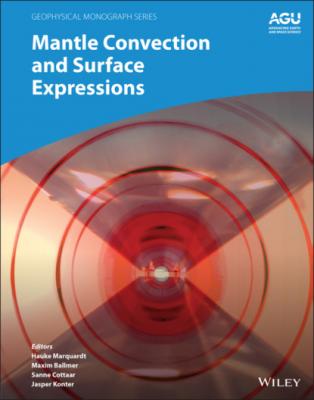Mantle Convection and Surface Expressions. Группа авторов
Чтение книги онлайн.
Читать онлайн книгу Mantle Convection and Surface Expressions - Группа авторов страница 61

Values in italics were estimated or adopted from other compositions/polymorphs of the same phase/compound.
S Isentropic bulk modulus.
* Original data were refit to the finite‐strain formalism of Stixrude & Lithgow‐Bertelloni (2005).
Figure 3.7 P-wave (a) and S-wave (b) velocities for different mineral phases and compositions along a typical adiabatic compression path starting at 1900 K and 25 GPa (see Figure 3.8). These mineral phases and compositions were mixed to model elastic wave speeds of rocks as shown in Figures 3.8 and 3.9. Dashed curves show P‐ and S‐wave velocities when the effect of relevant continuous phase transitions on elastic properties is ignored. See Table 3.1 for references.
Chemical bulk compositions for pyrolite and metabasalt were approximated by the depleted MORB mantle (DMM) and NMORB compositions of Workman and Hart (2005). In analogy to the approach of Xu et al. (2008), a hypothetical harzburgite composition was generated by assuming pyrolite to be an 80:20 mixture of harzburgite:basalt by mass. A basalt fraction of 20% in the mantle corresponds to the upper limit of estimates based on geochemical (Morgan & Morgan, 1999; Sobolev et al., 2007) and geodynamical arguments (Ballmer et al., 2015; Nakagawa et al., 2010). For pyrolite and harzburgite, mineral compositions were computed in the system CFMAS and for metabasalt in the system NCFMAS. Bulk compositions were partitioned into the phase assemblages bm‐fp‐cp for pyrolite and harzburgite and bm‐cp‐cf‐st for metabasalt resulting in approximate volume fractions of 77:16:7 (bm:fp:cp) in pyrolite, 74:24:2 (bm:fp:cp) in harzburgite, and 45:26:14:15 (bm:cp:cf:st) in metabasalt, respectively. For each phase, the compositions listed in Table 3.1 were mixed to match the computed mineral compositions as outlined in Section 3.6. For some mineral compositions, this approach required extrapolations beyond the compositional limits defined by the mineral compositions in Table 3.1. In these cases, the extrapolations of elastic moduli were restricted to not transcend compositional limits by more than 10% of the compositional range delimited by the mineral compositions of Table 3.1.
The exact mineral compositions and volume fractions for a given bulk rock composition depend critically on assumptions about element partitioning between minerals and the overall Fe3+/∑Fe ratio. To separate the effects of temperature and compositional parameters, I first computed P‐ and S‐wave velocities for each bulk rock composition setting Fe3+/∑Fe = 0.5 in bridgmanite for all rock compositions and requiring that (Fe/Mg)bm/(Fe/Mg)fp = 0.5 and 0.2 in pyrolite and harzburgite, respectively (Figure 3.6a), and that (Fe/Mg)bm/(Fe/Mg)cf = 1 and (Al/Mg)bm/(Al/Mg)cf = 0.2 in metabasalt (Figure 3.6b). For these reference scenarios, I computed adiabatic compression paths for each rock composition starting at 1900 K, 1400 K, and 2400 K at 25 GPa and mapped P‐ and S‐wave velocities between these compression paths based on the Voigt‐Reuss‐Hill average over all relevant mineral phases.
Figure 3.8 shows the modeling results for the reference scenario of each bulk rock composition in terms of deviations of the computed P‐ and S‐wave velocities from the seismic velocities of the preliminary reference Earth model (PREM; Dziewonski & Anderson, 1981):
Figure 3.8 Relative contrasts between modeled P-wave (upper row) and S-wave (lower row) velocities for pyrolitic (left column), harzburgitic (central column), and basaltic (right column) bulk rock compositions and PREM. Black curves show adiabatic compression paths for each rock composition and starting at 1400 K, 1900 K, and 2400 K at 25 GPa. For each rock composition, computed volume fractions of minerals and the choice of compositional space and parameters are given below the respective diagrams. See text for details of elastic wave speed modeling.
where vPREM stands for the P‐ or S‐wave velocity of PREM at the respective